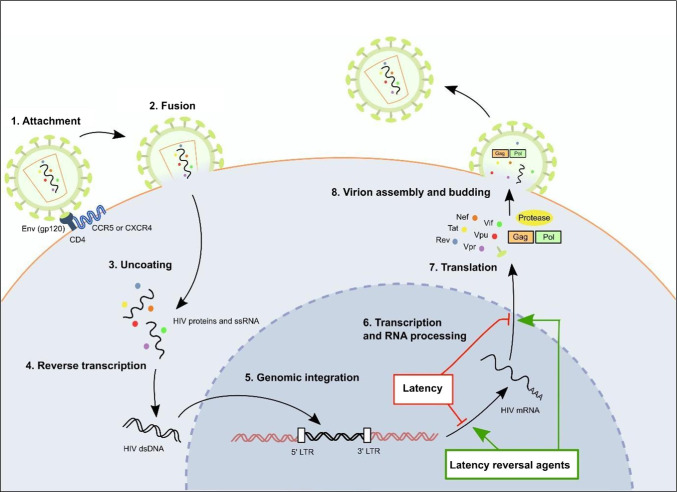Fig. 1.
HIV-1 life cycle and latency. To enter host cells, the HIV-1 gp120 Env protein binds to the host CD4 receptor and CCR5/CXCR4 co-receptors (1). Once bound, the HIV-1 viral envelope fuses with the host membrane and uncoats, releasing HIV-1 proteins and ssRNA into the host cell cytoplasm (2-3). HIV-1 ssRNA is reverse-transcribed into the dsDNA proviral genome using HIV-1 reverse transcriptase (4) and can integrate into the dsDNA host genome in the nucleus (5). Host genomic DNA containing the integrated HIV-1 transcript can then undergo transcription, RNA processing and translation to produce viral proteins, which assemble with viral ssRNA to form mature, infectious HIV-1 virions (6-8). Alternatively, interference with gene expression through mechanisms such as epigenetic silencing and/or post-translational modifications, can cause the replication-competent provirus to remain latent within the host cell. Certain chemical compounds, termed latency reversal agents, can reverse silencing mechanisms to reactivate latent HIV-1. Abbreviations: CCR5: C-C-motif chemokine receptor type 5; CD4: cluster of differentiation type 4; CXCR4: C-X-C-motif chemokine receptor type 4; dsDNA: double stranded DNA; Env: HIV-1 envelope protein; Gag: HIV-1 group specific antigen; gp120: HIV-1 glycoprotein 120; LTR: long terminal repeat; mRNA: messenger ribonucleic acid; Nef: HIV-1 negative factor protein; Pol: HIV-1 polymerase; Rev: HIV-1 response element protein; ssRNA: single-stranded RNA; Tat: HIV-1 transactivating protein; Vif: HIV-1 viral infectivity factor protein; Vpr: HIV-1 viral protein R; Vpu: HIV-1 viral protein U

